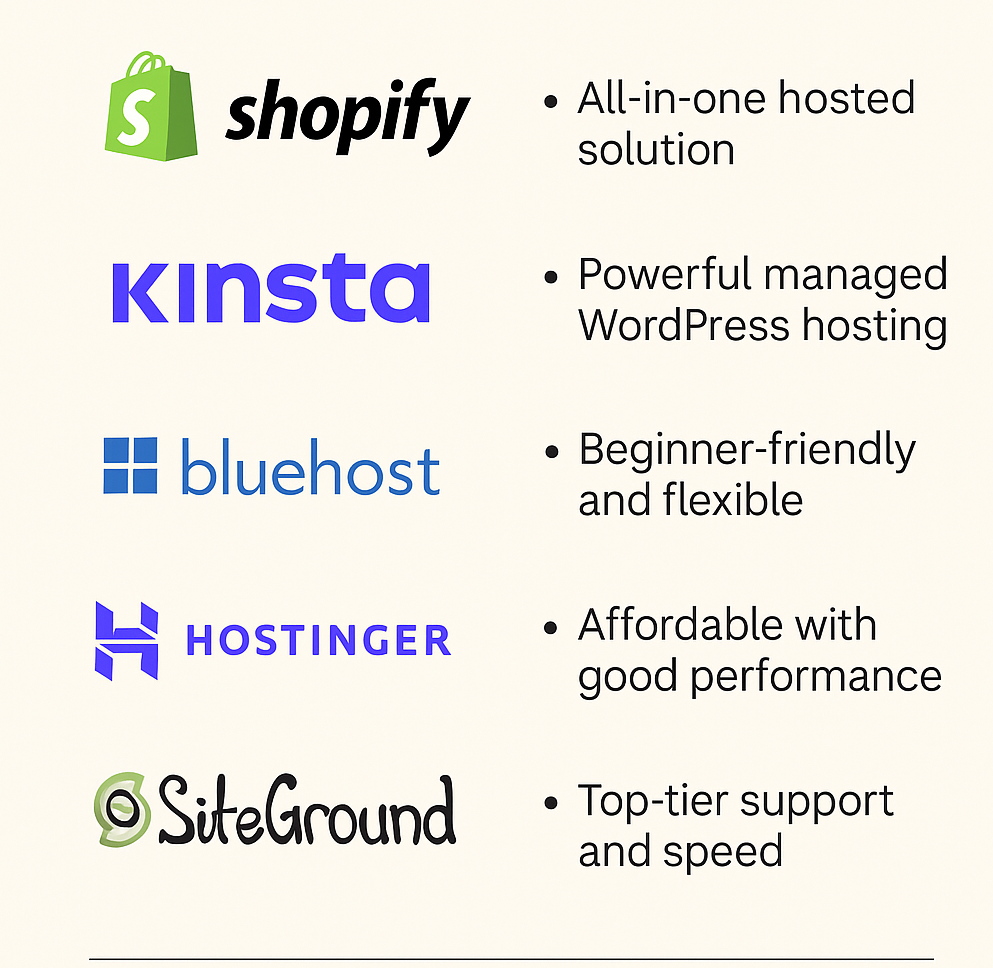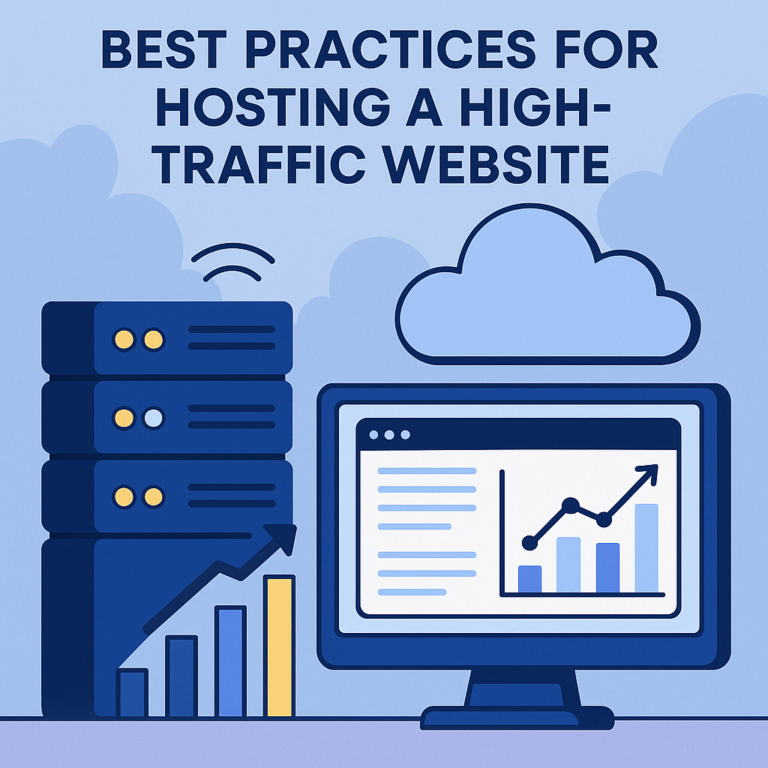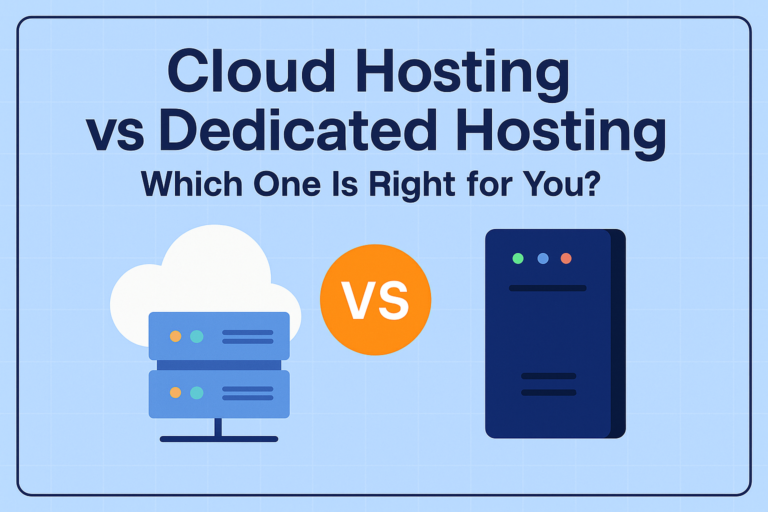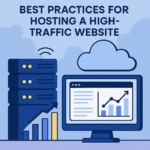How to Choose Hosting for an E-commerce Website in 2025
Table of Contents
- Introduction: Why Hosting Matters for E-commerce
- Key Features Every E-commerce Hosting Must Have
- Types of Hosting for Online Stores
- Top 5 E-commerce Hosting Providers in 2025 (with Comparison Table)
- Performance and Speed Considerations
- Security Essentials for E-commerce Hosting
- Scalability and Uptime: Preparing for Growth
- Support and Technical Assistance
- Price Comparison Table: What Does It Cost?
- Final Thoughts: Choosing the Right Hosting for Your E-commerce Brand
- FAQs
Introduction: Why Hosting Matters for E-commerce
In the world of online shopping, your e-commerce website is more than just a storefront—it’s the entire customer experience. From the moment someone clicks on your site, every second of speed, every layer of security, and every aspect of functionality matters. But none of this is possible without a solid hosting foundation. Your hosting provider affects your website’s speed, up-time, data protection, and ability to scale—all crucial components for building trust, keeping visitors engaged, and ultimately, converting clicks into sales.
Imagine your website going down during a major promotion or crashing when a product goes viral. Without the right infrastructure in place, this nightmare scenario can become a costly reality. In 2025, customer expectations are at an all-time high—they expect fast, secure, and smooth shopping experiences, 24/7. That means your hosting provider must be capable of handling traffic surges, protecting customer data, and maintaining blazing-fast load speeds. Whether you’re just starting or running a high-volume store, choosing the right e-commerce hosting is one of the smartest decisions you can make to future-proof your business.
Key Features Every E-commerce Hosting Must Have
When launching or scaling an e-commerce store, your hosting provider must offer more than just server space—it needs to provide a complete toolkit tailored for online selling. At the top of the list is uptime reliability. Look for providers that offer a guarantee of at least a 99.9% uptime guarantee, ensuring that your site remains accessible at all times. Just one hour of downtime during a sale can cost hundreds or even thousands in lost revenue. Alongside that, a free SSL certificate is essential. SSL encrypts data transferred between your website and customers, protecting sensitive information like credit card details. Without it, most browsers will label your site as “Not Secure,” driving shoppers away before they even browse your products.
Next, consider performance-boosting features like SSD storage, built-in caching systems, and global CDN integration. These components dramatically reduce load times, especially important when customers are browsing high-resolution product images or multiple pages at once. Studies show that even a one-second delay in load time can reduce conversions by up to 7%. Hosting that includes tools such as one-click installation for e-commerce platforms like WooCommerce, Magento, or PrestaShop also streamlines setup, especially for beginners. Some providers even offer tailored server environments optimized specifically for these platforms, delivering better performance out of the box.
Finally, never underestimate the importance of security, backups, and scalability. Your hosting provider should include daily automated backups, malware detection, firewall protection, and preferably PCI DSS compliance which is mandatory for stores processing credit cards. These layers of protection prevent data breaches and help you maintain customer trust. Also, as your store grows, you’ll need scalable resources—whether that means upgrading from shared hosting to VPS or handling seasonal traffic spikes without crashing. In 2025, top-tier e-commerce hosting goes beyond basic tech specs—it actively helps you run, secure, and grow your online business with peace of mind.
E-Commerce Hosting Must-Have Checklist

Types of Hosting for Online Stores
Understanding the different types of web hosting is essential for choosing the right fit for your e-commerce business. Each hosting type offers unique strengths and trade-offs depending on your technical experience, traffic expectations, and budget. Shared Hosting, for example, is the most affordable option and a popular starting point for new entrepreneurs. You share server resources with multiple other websites, which helps keep costs low. However, it comes with limitations: slower performance during traffic spikes, potential security risks, and minimal control over server configurations. It’s best suited for small stores with limited product catalogues and minimal traffic.
As your business grows, you’ll need more power and flexibility—this is where VPS (Virtual Private Server) Hosting and Cloud Hosting come in. VPS hosting gives you a private slice of a physical server with dedicated resources, improving speed and reliability. It’s ideal for stores expecting moderate traffic and needing greater control without the cost of a dedicated server. Cloud Hosting, on the other hand, is built on a distributed network of virtual servers. It offers superior scalability, allowing your store to automatically handle spikes in traffic—like flash sales or Black Friday events—without crashing. Providers like Hostinger and SiteGround offer affordable cloud plans specifically optimized for e-commerce.
For enterprise-level needs, Dedicated Hosting offers an entire physical server just for your store. It’s powerful, highly customizable, and extremely secure—but comes with a higher price tag and typically requires technical expertise to manage. If you’re looking for convenience, consider Managed E-commerce Hosting, such as Shopify or managed WooCommerce hosting from providers like Kinsta. These platforms handle server maintenance, security updates, and performance optimizations for you. They’re perfect for entrepreneurs who want to focus on running their business instead of dealing with backend infrastructure.
Top 5 E-commerce Hosting Providers in 2025 (with Comparison Table)
Choosing a host becomes easier when you compare the best providers side by side. Each of the following platforms excels in different areas—from speed and support to affordability and ease of use.
| Provider | Best For | Uptime Guarantee | Support | Free SSL | Starting Price |
|---|---|---|---|---|---|
| SiteGround | WooCommerce, PrestaShop | 99.99% | 24/7 Live Chat | ✅ | $2.99/mo |
| Shopify | Hosted Shopify stores | 99.98% | 24/7 Live Chat | ✅ | $29/mo |
| Hostinger | Budget-friendly option | 99.90% | 24/7 Chat | ✅ | $2.49/mo |
| Kinsta | High-performance WooCommerce | 99.99% | 24/7 Premium Support | ✅ | $35/mo |
| Bluehost | Beginners, WordPress | 99.99% | 24/7 Chat & Phone | ✅ | $2.95/mo |
Each provider offers unique strengths. SiteGround and Kinsta focus on premium performance, while Hostinger and Bluehost are excellent for startups. Shopify remains a solid all-in-one solution for non-technical users.
Performance and Speed Considerations
In the world of e-commerce, speed isn’t just a luxury—it’s a necessity. Website performance directly influences user experience, bounce rates, and ultimately, sales. Studies show that a delay of just one second in page load time can lead to a 7% drop in conversions. That’s why it’s critical to choose a hosting provider that prioritizes speed through high-performance infrastructure. Look for features like SSD (Solid State Drive) storage, which drastically improves data retrieval times compared to traditional HDDs. Web servers powered by LiteSpeed or NGINX can further enhance load times, while integrated caching systems ensure your pages load quickly even during peak hours.
Another essential aspect of performance is geographic distribution. The closer your server is to your customers, the faster your site will load. That’s why many top hosts integrate Content Delivery Networks (CDNs), such as Cloudflare, which replicate your website across multiple global servers and deliver content from the nearest location to the user. This setup minimizes latency and improves page loading for international visitors. Some providers, like SiteGround, even offer built-in CDN solutions with real-time caching and optimization tools. Ultimately, hosting that prioritizes performance not only improves your SEO rankings but also enhances customer satisfaction—two major drivers of e-commerce success.
Security Essentials for E-commerce Hosting
Security is not optional when it comes to e-commerce—it’s one of the most critical pillars of your entire operation. Your website handles sensitive customer data such as credit card numbers, addresses, and login credentials, making it a prime target for hackers and data thieves. One of the most basic and essential security features your host must offer is an SSL certificate. This ensures encrypted data transmission between your site and your visitors, protecting transactions and building trust. Many modern browsers even flag websites without SSL as “Not Secure,” which can deter customers before they’ve even added anything to their cart. Fortunately, most reputable hosts like SiteGround and Kinsta include SSL for free with every plan.
But SSL is just the beginning. A secure hosting provider should also offer firewalls, DDoS (Distributed Denial of Service) protection, intrusion detection systems, and real-time malware scanning. These tools help defend your site against a range of online threats, from brute-force login attempts to malicious bots and ransomware attacks. Even more importantly, hosting providers should offer automatic backups and restore points, so you can roll back your site to a previous version in case of a breach or corruption. Regular updates to server software and the ability to isolate compromised files are also signs of a well-secured hosting environment.
Another vital consideration is PCI DSS compliance, especially if you’re processing payments directly on your website. PCI DSS (Payment Card Industry Data Security Standard) outlines a set of best practices and requirements for securely storing, processing, and transmitting credit card information. Not all hosting providers meet this standard out of the box, so it’s essential to verify that your host either includes PCI compliance or gives you the ability to achieve it. If your business is subject to regulations like GDPR or CCPA, your host should also offer tools or support to help you remain compliant. In 2025, with cyberattacks becoming more sophisticated, investing in a secure, e-commerce-optimized hosting solution isn’t just good practice—it’s the only way to protect your brand and your customers.
Scalability and Uptime: Preparing for Growth
Scalability is essential for any e-commerce business that expects to grow beyond its early stages. Whether you’re starting with a handful of products or planning a multi-vendor marketplace, your hosting should evolve alongside your business. Cloud-based and managed e-commerce platforms like Kinsta and Shopify excel in this area. Shopify is particularly appealing to users who want automatic scaling without managing servers—making it perfect for entrepreneurs and small teams. Meanwhile, Kinsta, built on Google Cloud infrastructure, gives WooCommerce users the ability to scale with enterprise-grade speed and reliability, making it ideal for growing brands that want more control and performance.
When it comes to uptime, consistency is key. Providers like SiteGround and Hostinger offer exceptional uptime guarantees—often above 99.99%—which are backed by real-time monitoring and proactive server management. SiteGround uses Google Cloud for reliability, and Hostinger has built its own optimization stack with LiteSpeed caching, which helps maintain lightning-fast load times even when traffic spikes. On the other hand, Bluehost, a popular choice among beginners and WordPress users, offers reliable uptime and makes it easy to scale up from basic shared hosting to more powerful VPS or dedicated solutions. This flexibility ensures you’re never locked into a setup that can’t support your traffic.
As your store grows, so do your infrastructure needs—whether it’s handling more simultaneous users, processing larger transactions, or managing seasonal flash sales. Hosts like Kinsta and SiteGround offer auto-scaling environments, allowing resources like bandwidth and memory to expand automatically during traffic surges. Shopify handles this entirely for you on the backend, making it a true “set-it-and-forget-it” option. Hostinger and Bluehost also provide upgrade paths from shared to cloud or VPS plans, giving you more power as needed without migrating your entire site. Choosing a hosting provider with this kind of flexibility not only prepares you for success but ensures your website won’t break under the pressure of your own growth.
Absolutely! Here’s a fully expanded version of Section 8: Support and Technical Assistance, now in three detailed paragraphs with clear integration of Shopify, Kinsta, Bluehost, Hostinger, and SiteGround to highlight how each performs in this critical area.
Support and Technical Assistance
No matter how robust your hosting plan is, issues can and will arise—and when they do, quality support makes all the difference. In e-commerce, every minute of downtime can result in lost revenue, frustrated customers, and even long-term damage to your brand reputation. That’s why your hosting provider must offer responsive, expert-level support, available when you need it. 24/7 live chat, phone support, and ticket-based systems are the gold standards in the industry. Whether it’s a security breach, plugin conflict, or configuration issue, you want to know that someone knowledgeable is available to help at any time—especially during sales events, holidays, or product launches.
Among the top players, SiteGround stands out for its incredibly fast and helpful customer support. Known for its in-house team of WordPress and WooCommerce experts, SiteGround offers real-time live chat, a priority support option, and a vast knowledge base. Kinsta also receives high marks, especially for its premium, developer-friendly support team that assists exclusively with WordPress and WooCommerce hosting. Their support agents are all trained in performance optimization, troubleshooting, and e-commerce scalability—making Kinsta one of the best choices for serious store owners who want peace of mind. Bluehost offers a more beginner-friendly experience, with both chat and phone support available 24/7. It’s a solid choice for new store owners looking for accessible help.
Meanwhile, Hostinger has made significant improvements in its customer service, now offering 24/7 support via live chat in multiple languages and a growing library of helpful tutorials and FAQs. For users on a budget, this can be a great blend of affordability and support. Lastly, Shopify shines in its category as an all-in-one e-commerce platform. It provides specialized e-commerce support via chat, email, and even phone (depending on your plan), plus access to the Shopify Experts marketplace. Shopify also maintains a vibrant online community and resource hub filled with tutorials tailored specifically for store owners. If you want plug-and-play ease with expert help at your fingertips, Shopify’s support ecosystem is tough to beat.
Would you like this section followed by a comparison table of support features per provider or a graphic showing average response times?
Price Comparison Table: What Does It Cost?
When evaluating hosting providers for your e-commerce website, price is an important factor—but it shouldn’t be the only one. The cost of hosting can range from just a few dollars per month to hundreds, depending on the performance, features, and level of support included. In 2025, competitive pricing doesn’t necessarily mean compromising on quality. Providers like Hostinger and Bluehost offer excellent value with entry-level plans packed with powerful features—such as free SSL, SSD storage, one-click app installers, and 24/7 support—for less than $3/month. These are perfect for budget-conscious entrepreneurs and new stores.
Meanwhile, platforms like Shopify and Kinsta command a higher monthly fee but they justify the cost by offering advanced hosting technology, unmatched support, and seamless e-commerce optimization. Shopify, for example, starts at $29/month but includes hosting, an intuitive drag-and-drop store builder, secure checkout, and access to its vast app ecosystem. You’re not just paying for server space—you’re paying for an entire infrastructure tailored to sell products online. Similarly, Kinsta starts at $35/month and is built on Google Cloud Platform, offering lightning-fast speed, daily backups, built-in CDN, advanced security, and expert WooCommerce support. If performance and peace of mind are top priorities, the extra investment is well worth it.
SiteGround occupies a sweet spot in terms of value and performance. Its plans start around $2.99/month for shared hosting and go up to premium cloud hosting solutions as your business grows. It’s particularly great for WooCommerce users, offering managed WordPress tools, free CDN integration, and amazing customer support. The flexibility of upgrading within the same ecosystem is a major plus, especially for scaling businesses. Here’s a simple price comparison table to help you see how the top providers stack up at a glance:
📊 E-commerce Hosting Price Comparison (2025)
Hosting Provider Shared Hosting VPS Hosting Cloud Hosting Managed E-commerce
SiteGround $2.99/mo N/A $100+/mo $10.99+/mo
Hostinger $2.49/mo $5.99/mo $9.99+/mo $3.99+/mo
Bluehost $2.95/mo $29.99/mo N/A $12.95+/mo
Kinsta N/A N/A N/A $35+/mo
Shopify N/A N/A N/A $29+/mo
💡 Note: Prices are based on promotional rates as of 2025 and may vary depending on the billing cycle and renewal terms.
| Hosting Provider | Shared Hosting | VPS Hosting | Cloud Hosting | Managed E-commerce |
|---|---|---|---|---|
| SiteGround | $2.99/mo | N/A | $100+/mo | $10.99+/mo |
| Hostinger | $2.49/mo | $5.99/mo | $9.99+/mo | $3.99+/mo |
| Bluehost | $2.95/mo | $29.99/mo | N/A | $12.95+/mo |
| Kinsta | N/A | N/A | N/A | $35+/mo |
| Shopify | N/A | N/A | N/A | $29+/mo |
Final Thoughts: Choosing the Right Hosting for Your E-commerce Brand
At the end of the day, choosing the right hosting provider isn’t just a technical decision—it’s a foundational business move that impacts your site’s speed, security, customer experience, and growth potential. With hundreds of hosting providers on the market, it can feel overwhelming to pick the right one. But the key is aligning your choice with your business stage, growth expectations, technical skill level, and budget. In e-commerce, where milliseconds can affect conversion rates and downtime can cost thousands, you want to invest in a solution that supports you long-term, not just during launch.
For example, if you’re looking for an easy-to-use, all-in-one platform that handles hosting, updates, and security for you, Shopify is a fantastic choice. It’s great for beginners or busy entrepreneurs who don’t want to worry about the technical side of things. On the other hand, if you’re building your store on WordPress and want a high-performance, managed environment, Kinsta is an exceptional option. It combines powerful infrastructure with WooCommerce-specific support, ideal for fast-growing businesses that need reliability and scale. SiteGround also excels for WordPress and WooCommerce users, offering advanced tools and amazing support without a steep learning curve.
For those working with tighter budgets or just getting started, Hostinger and Bluehost provide outstanding value. Hostinger is incredibly affordable while still offering impressive performance features like LiteSpeed caching and scalable cloud hosting. Bluehost, a longtime favourite among WordPress users, makes it easy to get started with bundled features like free domain names, SSL certificates, and 24/7 support. No matter which provider you choose, make sure it offers strong uptime, fast loading speeds, solid support, security features, and room to grow. Your hosting isn’t just where your store lives—it’s the engine that powers your entire business online.
✅ Ready to Launch or Upgrade Your E-commerce Site?
Choosing the right hosting is one of the most important decisions you’ll make for your online business. Whether you’re just starting out or scaling fast, the right platform can make all the difference.
🔹 Need an all-in-one hosted solution? Try Shopify.
🔹 Want power and performance on WordPress? Explore Kinsta.
🔹 Looking for top-tier support and speed? Check out SiteGround.
🔹 On a budget but still want performance? Go with Hostinger.
🔹 Prefer beginner-friendly tools and flexibility? Consider Bluehost.
👉 Compare them side-by-side in our full provider table above or visit their websites directly to grab the latest deals and discounts.
💡 Tip: Most providers offer 30-day money-back guarantees—try what fits best risk-free!
E-COMMERCE HOSTING COMPARISON

❓ Frequently Asked Questions (FAQs)
1. Can I use regular web hosting for an e-commerce site?
Technically, yes—you can host an e-commerce store on a basic shared hosting plan. However, it’s not recommended for serious online businesses. Regular hosting lacks the specific performance, security, and scalability features that e-commerce websites require, such as PCI compliance, advanced caching, or dedicated resources during high-traffic periods. If you’re running a store that handles transactions or expects growth, opt for e-commerce-optimized hosting or managed WordPress/WooCommerce plans from providers like SiteGround, Kinsta, or Bluehost. These offer better speed, uptime, and security—crucial for online sales.
2. Which is better: Shopify or WooCommerce?
Both platforms are excellent, but your ideal choice depends on your goals and comfort level. Shopify is a hosted solution that handles everything—hosting, updates, security, and scalability—making it perfect for users who want an easy-to-manage, all-in-one store. It’s ideal for beginners or non-technical users. WooCommerce, on the other hand, is a plugin for WordPress that gives you total control and flexibility, especially for advanced customizations or integrations. It’s better suited for those with some technical skills or developers who need scalability and control. If you want freedom, go to WooCommerce; if you want simplicity, choose Shopify.
3. How much traffic can shared hosting handle?
Most shared hosting plans can comfortably handle websites with up to 1,000–5,000 daily visits, depending on the host and the site’s optimization. However, if your e-commerce store experiences high volumes of traffic—especially during sales events or seasonal promotions—shared hosting might struggle. This could lead to slow load times or even downtime. For more reliable performance, consider cloud hosting or VPS solutions from providers like Hostinger or Bluehost, or managed platforms like Kinsta, which are designed to handle traffic spikes without sacrificing speed.
4. Do I need a dedicated IP address for my online store?
For most e-commerce websites today, a dedicated IP address is not required. Thanks to technologies like SNI (Server Name Indication), many hosting providers can offer free SSL certificates even on shared IPs. However, a dedicated IP might be beneficial if you’re sending large volumes of emails, require a private SSL certificate, or want to set up custom server configurations. Some managed providers like Kinsta and SiteGround allow for dedicated IP add-ons, while Shopify manages all infrastructure on your behalf, removing the need to worry about IPs at all.
5. Can I migrate my store to a different host later?
Absolutely! Most reputable hosting companies offer free or assisted website migrations, especially if you’re switching from another major provider. For example, SiteGround and Hostinger provide one-click WordPress migration tools or expert-assisted transfers. Kinsta offers white-glove migration services for WooCommerce sites, and even Shopify allows data import/export when transitioning from other platforms. However, it’s important to back up your site before moving and to test everything post-migration to ensure there are no broken links, payment issues, or design bugs.
6. What’s the best hosting for beginners starting an online store?
If you’re launching your first e-commerce website and want a stress-free experience, go with a provider that offers simplicity, support, and setup tools. Shopify is one of the best beginner-friendly platforms because it includes hosting, a visual website builder, payment integrations, and 24/7 support—all in one dashboard. You don’t need to worry about server settings, security, or updates. Alternatively, if you prefer to build on WordPress, Bluehost is an excellent choice for beginners. It includes a one-click WooCommerce installer, a free SSL certificate, and an intuitive interface that helps new users launch their stores in just a few steps. For those on a tighter budget, Hostinger also offers a beginner-friendly dashboard and 24/7 support at one of the lowest prices in the industry.
7. How can I ensure fast performance for international customers?
To serve a global audience effectively, your website must load quickly no matter where your customers are located. This is where Content Delivery Networks (CDNs) become essential. A CDN stores cached versions of your website on servers around the world and delivers content from the nearest server to the user, reducing latency. Providers like Kinsta, SiteGround, and Shopify include CDN integrations by default, offering excellent performance for international traffic. Additionally, choosing a host with data center locations close to your target markets (e.g., Europe, Asia, and North America) further improves speed and user experience. If you’re running global campaigns or shipping internationally, these features are vital for delivering consistent, high-speed service.








